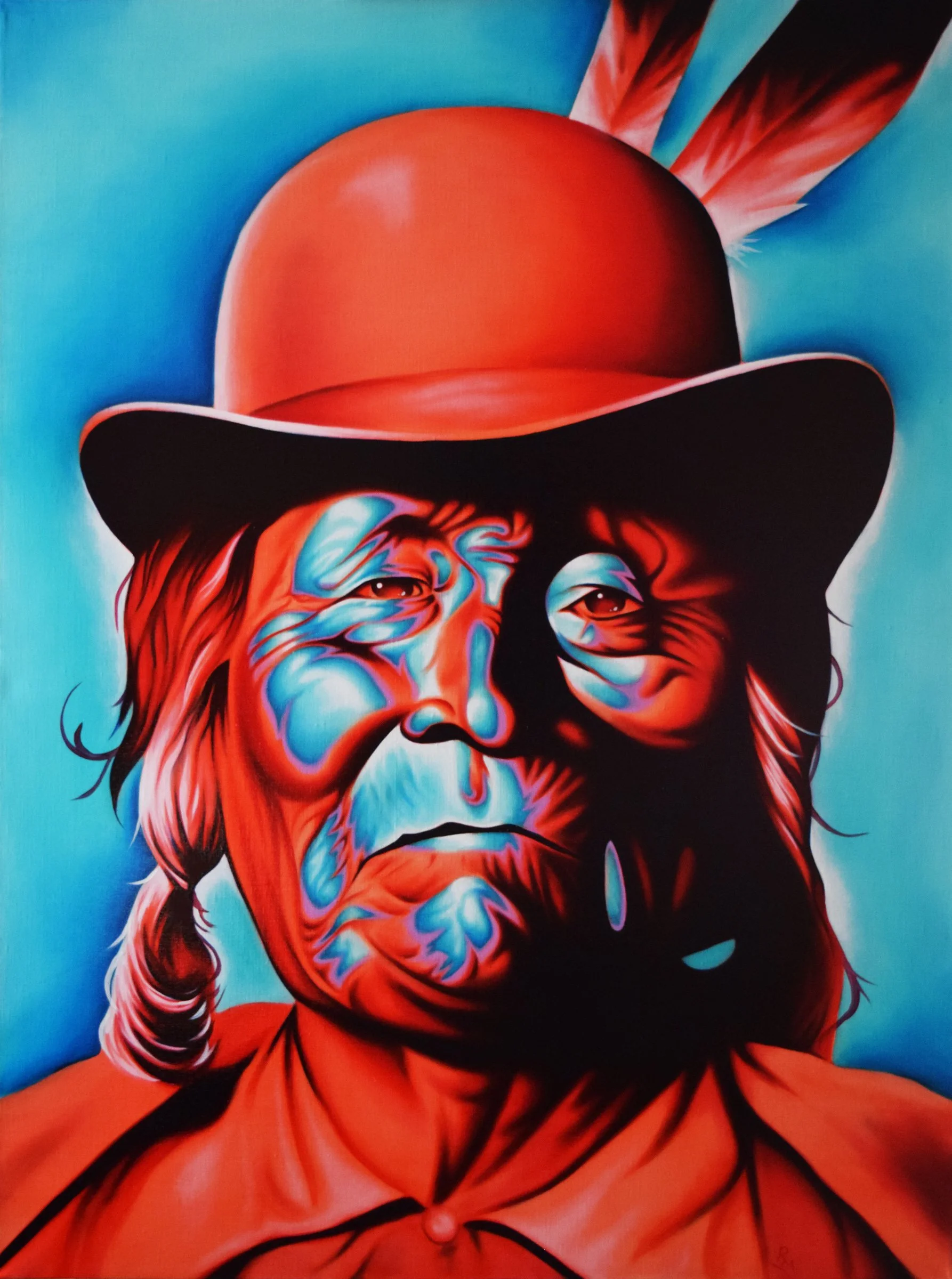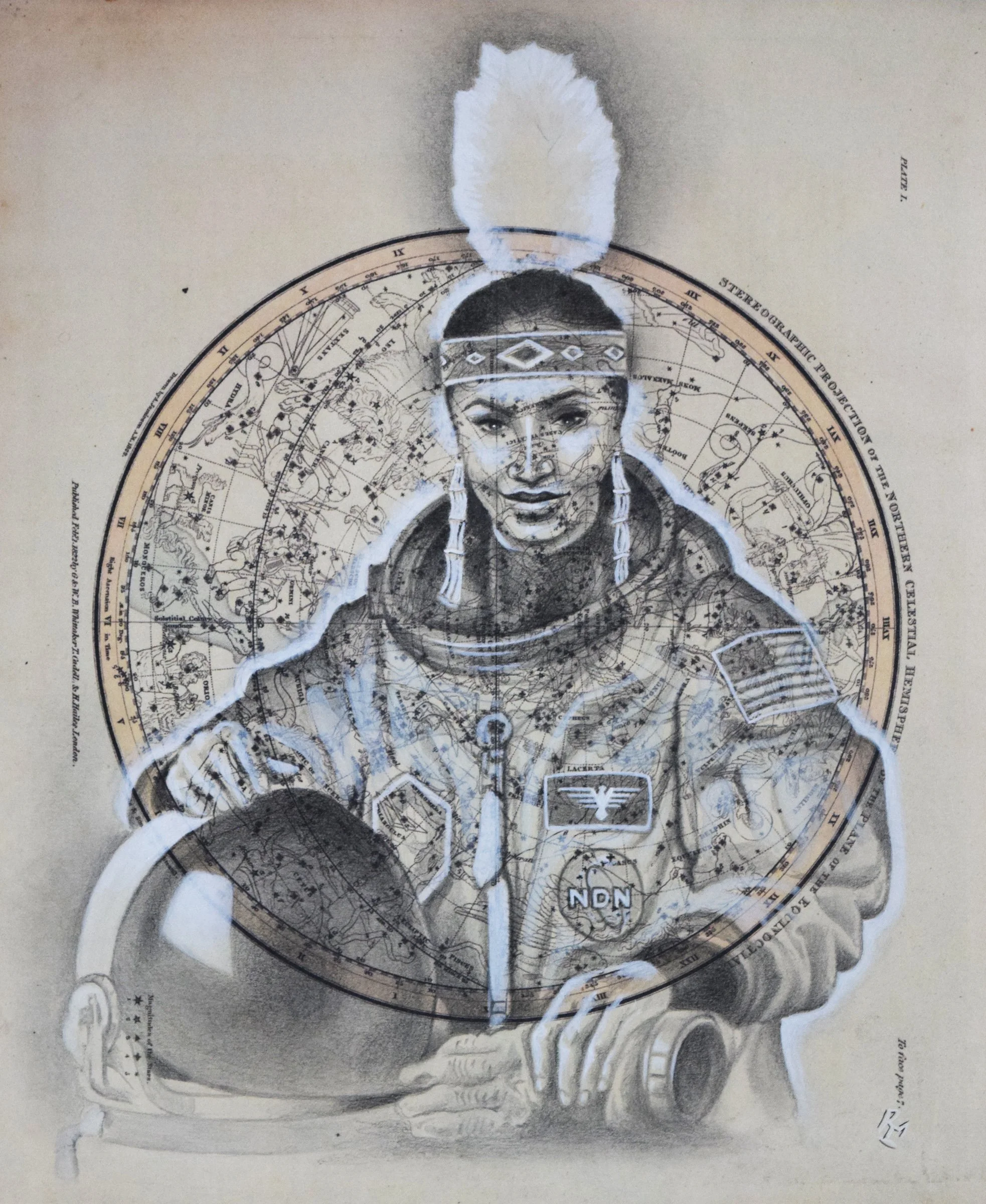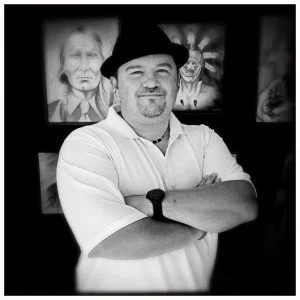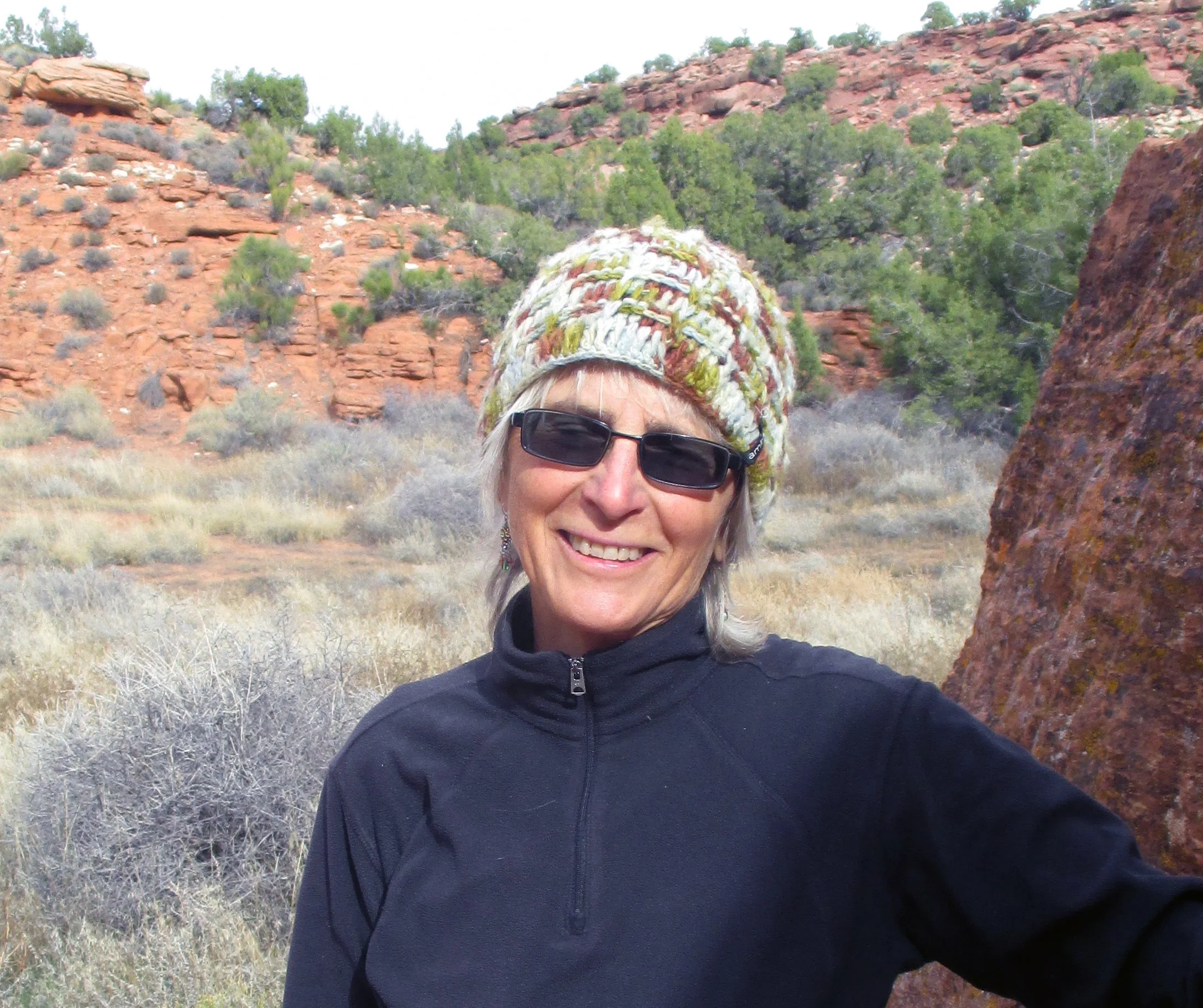“I Am Right Here In Front of You”: An Interview with Robert Martinez
by Connie Wieneke
“West Werld” by Robert Martinez; 11in x 14in, graphite & acrylic on vintage map image.
With the exception of his art school tenure at the Rocky Mountain College of Art & Design, visual artist Robert Martinez has lived most of his life on or near the Wind River Indian Reservation in west central Wyoming. As a Northern Arapaho with Mexican, Spanish, Scots-Irish, and French Canadian ancestors, Martinez employs contemporary and traditional images in his work, whether in a riff on traditional ledger art or in larger-than-life portraits. He and his wife, Veronica Martinez, a graphic designer, have owned and operated Martinez Art & Design since 1991.
HDJ contributor Connie Wieneke conducted the following interview with Robert Martinez on March 6, 2022, at The National Museum of Wildlife Art in Jackson, Wyoming, where the artist was giving a public talk and demonstration.
Connie Wieneke: When I talked with you last July at Crazy Horse Memorial, you said being a full time artist wasn’t realistic. So, why go for it despite that realization?
Robert Martinez: You know, I’m kind of ornery, so the fact that I could be my own boss was very appealing. When I was a younger guy—especially right after art school—you were expected to court a gallery, but that isn’t really that easy. I had to “get a day job,” but I was still doing artwork and selling it here and there. It was always the goal.
CW: Is that realization tied to you being Northern Arapaho, that Indigenous peoples and non whites have a more difficult time making it as a professional artist?
RM: It is a problem for any artist, but I think specifically for artists of color. I get labeled a “Native artist,” but I paint people who just happen to be Native. Other people are “portrait artists,” and I’m not? There was also a big disconnect between the professional art world and what they taught you about the professional art world in art school. They need to have a practical class for that, and it has to include online marketing. It’s so important, especially for someone like me in a rural area. Unless you are extremely lucky or already have a good gallery that represents you . . .
CW: What was the final trigger?
RM: I had been in the Native fine art game for long enough to have had a certain amount of success. At the time, I was working as director for a tribal program that I loathed—I was good at it, but it wasn’t what I wanted to be doing. If I’m going to be spending all this time and energy and worry, I could put that into my own thing. If I fail, I fail by myself.
“Baller”, 14in x 11in, Graphite & Acrylic on Antique 1871 Ledger Paper
CW: How does educating the public and other tribespeople play into your art? From our earlier conversations, I know that was instrumental in forming the Creative Indigenous Collective (CIC) in 2016, right?
RM: Yes, and there’s the Northern Arapaho Artists Society. We didn’t have any venues. I helped co-create both [organizations]. Their focus is very similar: trying to find venues, trying to find ways where Natives can tell their own stories and make a living creatively. The CIC [whose other founding members include Louis Still Smoking, Ben Pease, John Pepion, Lauren Monroe Jr., Holly Young, and Gina Still Smoking] tries to have two shows each year. I was the bridge between the CIC and the Society, and we did a show called “Collectively” in 2017 at the Wyoming State Museum.
CW: How do the collective and you, personally, work to change the various attitudes that consider Native American art as a “sub-genre?”
RM: Starting with these small conversations. Getting the foot in the door. Communicating. My work is usually specifically with people. That’s what interests me, and if I can educate and we can have a dialogue, then I think I’ve done my job, as an artist—and as an ambassador, I guess would be the best word. Hey, maybe, do some research before you buy that fake Indian stuff. I don’t want to argue with people.
CW: How do your paintings and drawings (even your graphic art featured on t-shirts and hoodies) push back against the prevailing—let’s say non-Native—assumptions about modern Indians?
“Hatter”, 40in x 30in, Airbrushed Acrylic & Oil on Linen
RM: I paint mostly Native people because that’s who I’m around. But I don’t exclusively paint Native people. There are those non-Native artists who paint almost exclusively Natives, but they don’t do that with any other culture. They don’t do that with African Americans. You don’t see non-Asian people painting only Asian people. When they do that with Natives, they appropriate our symbols and while they use them aesthetically, they have no background to draw on for the meanings. So in many cases they use them incorrectly, or when they shouldn’t. It’s far more acceptable for people to do that with Native imagery than with any other kind of culture, that I know. That’s kind of continued on to today. If you do this kind of thing for your whole body of work and you don’t know the cultures that you are appropriating from and you don’t give back anything to those cultures, I think that’s a problem. They could paint and draw anything in their style, but why does it have to be this?
CW: In the past we’ve spoken about Edward Curtis and how he “jazzed-up” his images of Native peoples; how they were staged, especially in the portraits. Your images are jazzed-up in a different way. Anything but faded. Can you talk about that?
RM: My big thing is poking holes into those assumptions or romanticized ideas about Native people and The West. I don’t just limit my art to Native people. I don’t limit it to ideas about how tough we are in The West, especially here in Wyoming. Cowboy tough. People have to realize that’s a “good”story, but it wasn’t (and isn’t) the real thing.
CW: You do “jazz”up the colors you use, especially in the paintings. I love the ledger art because there’s more, let’s call it “commentary.”But the other ones have this depth to them that comes from all those layers of paint that you’re putting on and the contrasting colors.
RM: Right. So I use those bright colors to combat those black and white, and sepia-toned photos of Native people by Curtis and other people. You start getting this idea that the Native peoples are gone. They’re dead. They’re not here. It’s all history. So that’s why I paint in those vibrant, bold colors, and frequently use an image of a person that stares back in a confronting way. I want them looking back at you (the viewer) and saying, “No, no, you look at me. I’m right here in front of you. We are here in front of you.”
"Black Coyote in Blue”, 18in x 24in, Airbrushed Acrylic & Oil on Panel with raised accents
CW: What artists have inspired you most? What influence has your community had in your art?
RM: My contemporaries. I’ll see them posting on social media and I’ll think “Man, that looks great. I got to bring it next time I do something.” When I see their success, I always applaud it, but it also makes me want me to do something. How do I make that happen in Wyoming?
CW: The Wyoming State Museum has purchased a piece of art (“Young Warrior”) that was part of the 2022 Capital Art Exhibition. This two years after you received the Governor ’s Arts Award. Your work is in permanent collections, like the Brinton Museum and the Smithsonian Institution (“4 Arapaho Leaders”). Last year you painted two large murals for Montana State University. Shows are starting to fill up the current calendar. You must be doing something right. How important are these kudos and purchases to your art and your career outside of Wyoming?
RM: With my kind of inside knowledge of the art game I don’t put very much emphasis on awards. It does feel good to be acknowledged and it was very surprising by the way.
“Why”, 40in x 30in, Airbrushed Acrylic & Oil on Linen
CW: When I look at your art, I feel like the subject in the work considers me as the viewer as much as I consider the subject. Does that make sense? Am I crazy to see/feel that? Even when the subject is looking at their cell-phone, they ask me to consider them.
RM: You’re right. I always consider the viewer when I do a piece. There are some artists I would say, specifically Native artists that I know, that do very dense work, very tribal—their tribe—and aesthetically it’s great, but as a viewer there are times I go, “I don’t know what that means.”I know what that mean in my tribe, but what does that mean in your tribe. And it takes them a while to explain it. If I can get (something) across in the least amount of detail or the least amount of abstraction possible, then I’m doing my job. I want it to be seen by as many people as possible. I don’t want my art to be seen by just one segment of society.
CW: Who do you turn to when you’re pushing a piece of art—visually, technically, emotionally— for feedback, that person you trust?
RM: I do have a handful, those artists (in the CIC) like Louis (Still Smoking) and John (Pepion). My wife is usually first. She’s an international award-winning graphic designer, so she’s got the skill. You aren’t done yet? And that’s when I go, No I’m not done.
Featured Art by Robert Martinez
“Acknowledge”, 14in x 11in, Graphite & Acrylic on Vintage Map Image
“Baller”, 14in x 11in, Graphite & Acrylic on Antique 1871 Ledger Paper
"Bear Tracks”, 16in x 20in, Airbrushed Acrylic & Oil on Panel with raised accents
"Black Coyote in Blue”, 18in x 24in, Airbrushed Acrylic & Oil on Panel with raised accents
“Hatter”, 40in x 30in, Airbrushed Acrylic & Oil on Linen
“Matriarch”,16in x 20in, Airbrushed Acrylic & Oil on Panel with raised accents
“Not An Ornament II”, 13.5in x 9in, Graphite & Acrylic on Antique 1871 Ledger Paper
"NDN Time”, 11in x 14in, Graphite & Acrylic on Vintage Map Image
"Sky People”, 14in x 11in, Graphite & Acrylic on Vintage Map Image
“West Werld”, 11in x 14in, Graphite & Acrylic on Vintage Map Image
“Why”, 40in x 30in, Airbrushed Acrylic & Oil on Linen
Robert Martinez was born in Wyoming on the Wind River Reservation in the small city of Riverton. He grew up a part of many different cultures as his lineage is Spanish, Mexican, Scotts Irish, French Canadian and Northern Arapaho. He graduated Riverton High School at 17 and through a scholarship, attended the Rocky Mountain College of Art & Design. He graduated with a Bachelor of Fine Arts specializing in Painting & Drawing and minoring in sculpture. In 3 years and at age 19, he became the Youngest Native American to graduate from RMCAD at that time.
As he was brought up in the center of the reservation, his native heritage remains a constant inspiration and source of ideas for his work. Living in among the hard working people of the West and experiencing their issues also deeply influence his creations. The past and present resonate strongly in Wyoming and those historical and contemporary chords echo throughout his pieces.
Much of Robert’s current work uses the historical imagery, myth’s and stories of the West & Arapaho Culture combined with modern themes to create images that have a statement on the issues of today. Using intense vibrant color and contrasting shades of light and dark, he paints and draws striking forms that are confronting and engage the viewer.
His paintings and drawings have been shown across the Nation and have garnered noted acclaim. His work is included in the permanent collections of the Red Cloud Heritage Museum, The Brinton Museum, The Plains Indian Museum at the Cody Center of the West, and the Smithsonian National Museum of the American Indian.
A strong supporter of Education and of the Arts, Robert devotes time to helping and mentoring emerging artists on his reservation in Wyoming and the western region. He gives back to the community by speaking about art topics, giving workshops, and demonstrates his style to schools, agencies and art groups.
Connie Wieneke's most recent or forthcoming work has appeared in The Forge Literary Magazine, Stand, Weber: The Contemporary West, Talking River Review, Pilgrimage, Camas, Split Rock Review, and Burningword Literary Journal. Her prose and poetry also have appeared in several anthologies, including Orison 6 Anthology and Rewilding: Poems for the Environment. Since 1983 she has lived in Wyoming where she has worn many hats. She received an MFA in creative writing from the University of Montana and two literary fellowships from Wyoming Arts Council.














